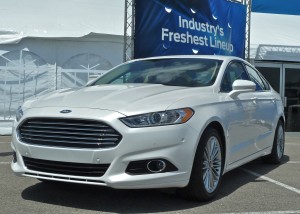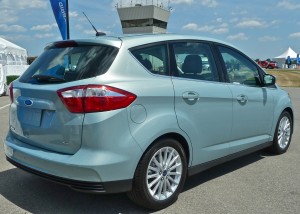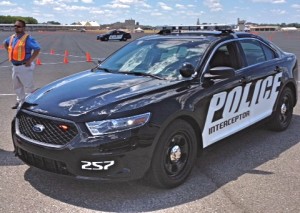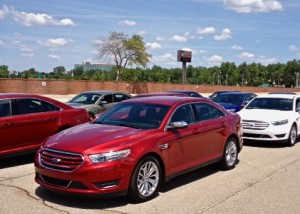Ford adds 1.0-liter EcoBoost to Focus

Ford hasn't yet introduced the 2013 Fusion, but it is the company's inspiration and technical halo car.
By John Gilbert
DEARBORN, MICH. — Smaller is big at Ford these days, and for 2013 the Dearborn company is expanding its highly successful EcoBoost technology to even smaller engines that will outwork larger ones while increasing fuel economy. Can you imagine a company that makes an impressive 6.2-liter V8 in its trucks will also be offering a 1.0-liter, 3-cylinder that propels a compact Focus with quick agility?
Ford Motor Company gained enormous amounts of respect and credibility when it foresaw the economic downturn and reacted strategically enough that it didn’t need the government loans that bailed out General Motors and Chrysler. Almost daily, I run into folks who have never been Ford fanciers but who now say they intend to examine Ford’s array of products before making their next purchase.
With that as background, dozens of automotive media types were herded to Dearborn for an advance check on the company’s 2013 vehicles, inside the secured walls of Ford’s Development Center.
I was able to fly in and out of Detroit on the day of the unveilings, so when I was whisked to the Tech Center, the groups of journalists had already started off in their four different groups. I was bused to the location of a lecture, but outside, I spotted a line of Focus sedans and hatchbacks on a tight little road-course, so I ambled over that way. Several Ford officials put me into a Focus and turned me loose. I zoomed away without a sound, because I was driving the new Focus Electric, with no gas-engine backup. Housing a new lithium-ion battery pack with permanent magnetic electric traction motor, the car had surprising quickness and, naturally, no emissions as well as no sound. The system is designed to produce 143 horsepower and 184 foot-pounds of torque, reaching a top speed of 84 mph, and go 76 miles on a full charge, which takes four hours on a 240-volt home-charging station. It will cost $39,200, and obviously is designed to challenge the Chevrolet Volt, Nissan Leaf, Mitsubishi Miev, Honda Fit Electric and all others.
That’s a lot of money for a Focus-size car, but that’s where costs are at these days in creating electric cars. Ford also has an electric-powered C-Max compact wagon, the Energi, being sold in Europe with pure electric, and coming to the U.S.

Based on the Focus, the C-Max will first come to the U.S. as hybrid or electric, but the 1.0 EcoBsoost is sure to follow.
Next, I climbed into a different Focus — I suppose you could say I reFocused — and took off around the same course, up and down some little hills and around some tight curves. This was obviously powered by a gas engine, but what an amazing gas engine! Designed and built in Europe, where it raked in all sorts of awards such as best new engine and 2012 engine of the year by the largest vote margin ever among 76 journalists from 35 countries, this engine is a tiny 1.0-liter in displacement, with only three cylinders.
It is the newest and smallest of Ford’s EcoBoost engines, which apply turbocharging to extract surprising power from reduced displacement. The Focus 1.0 comes in two versions, one with 98 horsepower that attains 58.9 miles per gallon, and the other with a more potent 123 EcoBoosted horsepower, getting “only” 56.4 mpg.
Trust me, the Focus with the 1.0 EcoBoost has plenty of power and is fun to drive around the curvy little road course, so it would be a blast to drive in the real world. And, it will make you wonder why we’ve been bothering to buy larger and far less-efficient engines all these years. The 1.0 will be coming in the Focus for 2013, and while there was no mention of it being in the smaller Fiesta as well, that seems only logical.
EcoBoost remains the prominent buzzword at Ford, and with good reason. The company now makes the 3.5-liter V6 with twin turbochargers as its top EcoBoost, and also has the 2.0-liter 4-cylinder, and the new 1.6-liter 4-cylinder to handle vehicles larger than the Focus.
To get to EcoBoost level, Ford isn’t just taking an existing engine and slapping a turbocharger on it. It is building the engines out of stronger materials so that the 3.5, 2.0, and 1.6 come from the ground up reinforced to handle the heat and quicker revving from the more potent fuel-air mixture being thrust into the intake chamber via turbocharging.
While Ford certainly isn’t abandoning the hot V8 in the Mustangs — from the supercharged Shelby 500 to the Boss 302, Laguna and GT models — and the biggest 6.2-liter V8 still powers the top trucks, EcoBoosts rule the realm at Ford and will be increasing their presence.
The Focus ST’s 2.0 EcoBoost shows 160 horsepower at 6,500 RPMs and 146 foot-pounds of torque at 4,450 RPM, but the transmissions available are the 6-speed Powershift shifter, but without paddles. High-pressure direct injection and continuous valve timing give the Focus ST 26-36 mpg city or highway, while the automatic has 28/38. The price is right, starting at $16,200.
The larger Taurus, which has been slightly redesigned to more closely resemble — and cash in on — the stunning look of the coming Fusion, shows the best example of what’s good about EcoBoost. The 3.5 V6 has 25 more horsepower thanks to the improved valve timing control, hitting 288 at 6,500 revs, with 254 foot-pounds of torque at 4,000 RPMs. Te 2.0 EcoBoost 4, however, comes close to matching the horsepower, with 240 at 5,500 RPMs, while outpowering the bigger V6 with 270 foot-pounds of torque at only 3,000 RPMs. The SHO’s EcoBoost 3.5 V6 has a poerful 365 horses and 350 foot-pounds of torque, with all-wheel drive, and still manages 25 miles per gallon by EPA estimate.
One of the fun things at the presentation was to head over to a large autocross course where we drove the Mustang Boss 302, and an adjacent handling course where we got to drive the Taurus Police Interceptor, complete with light bar above the black and white paint scheme. The Interceptor, beefed up for the most rugged police duty, has 288 horsepower and 254 foot-pounds of torque with the 3.5 naturally-aspirated V6, or an EcoBoosted version of the 3.5 that gets the SHO’s 365 horsepower and 350 foot-pounds.

Bad guys might be run down by an EcoBoosted 365-horsepower Taurus Police Interceptor, getting 30 mpg.
At the other end of the car spectrum, the Fiesta has the 1.6 naturally aspirated with 120 horsepower and 112 foot-pounds of torque, showing EPA estimates of 28/37 with the 5-speed stick, and 29/38 with the 6-speed auto. It will start at $13,200, which will slot it right there with the Honda Fit, which also offers only a 5-speed but does offer paddles on the automatic, albeit at a higher sticker price, and the Korean tandem Hyundai Accent/Kia Rio, both of which have the same size 1.6-liter engine but offer either a 6-speed stick or 6-speed automatic.
As a former owner of the 1970 Boss 302 Mustang, I really enjoyed flying around the autocross in the new Boss 302, with its 444 horsepower at 7,400 RPMs, and 380 foot-pounds of torque at 4,500. The 6-speed stick is the only transmission available, and it puts the power through the rear axle with sudden force, and the non-independent rear suspension continues to work very well — particularly if you want to toss the car around a little in the curves.
The Boss 302 this year more closely resembles the 1970 Trans-Am championship Mustang driven by Parnelli Jones with the side striping treatment. I criticized the current Boss 302 stripe, because the car most closely resembles the 1970, but had the sloped, horseshoe-shaped striping of the 1969 model — the only other year the Boss 302 was originally built. The new car has that “hockey stick” shape of reflective striping running down off the hood and then back on either side. My first impression is that the downward stripe isn’t slanted as much as the original, but it’s a vast improvement.
That is not to say Ford has solved all of my criticisms of a car that I still hold near and dear to my heart. I was writing about the Trans-Am road-racing series back then, and always enjoyed watching and interviewing the colorful Parnelli. The No. 15 and 16 cars Bud Moore race cars he and teammate George Follmer drove were a fantastic bright orange color. Not dark, deep burnt orange, but a vibrant, true orange, instantly memorable to anyone who saw it beat Mark Donohue’s dark blue Camaro.
Parnelli Jones, in his typical manner, called the standout orange team cars “school bus yellow.” In those days, school buses were either orange or yellow, for safety visibility, and Jones very likely was just beinga bit chippy by calling the orange car yellow. Rumor has it, a color called “school bus yellow” has now been patented, so Ford, in its quest to be as accurate as possible, must have paid the guy a large licensing fee to be able to offer the 2013 Boss 302 in “school bus yellow.”
Unfortunately, the historically-challenged Ford Motor Company folks are happily marketing the Boss 302 in bright canary yellow, to go along with the name, instead of the more accurate — and eminently more stunning — orange of the original. I could be tempted to buy an orange Boss 302, but I have no interest in a yellow one. Can’t these guys find an old color photo or video of the real race car, and get it right? Ah well, maybe next year.
The other biggest news from Ford for the upcoming year is its new devotion to helpiing offset the problem of driver distractions. All sorts of sensors and computers help monitor the driver’s heart rate, breathing rates, hand and facial changes, via the steering wheel, seats, seatbelts, camera monitors and other subtle implements to measure variations of workload. Such things as adaptive cruise control, active parking assist, and cross-traffic alert help, and coordinating those with the advanced MyFordTouch, which allows the driver to use voice commands and keep his or her hands on the wheel while phoning or changing the heat/air or audio controls.
Very impressive. There’s only one flaw in that whole system. Putting shift paddles on the steering wheels of all models would eliminate the non-intuitive electric button on the side of the gear shift lever for manually overriding the automatic transmission. How ironic that Ford would promote keeping your hands on the wheel as much as possible, and then bypass such a simple solution and make you take one hand off the wheel to manually shift gears.
Maybe when the researchers check out the biometrics from the seatbacks and breathing rates from the shoulder belts they will also reflect added anxiety every time the driver reaches away from the steering wheel to find that odd little switch for a manual downshift. True, they aren’t used much, but in this case it’s a self-fulfilling deal, because the ability to keep your hands on the wheel outweighs the desire to manually downshift, so maybe nobody uses it.
Comments
Tell me what you're thinking...
and oh, if you want a pic to show with your comment, go get a gravatar!



 John Gilbert is a lifetime Minnesotan and career journalist, specializing in cars and sports during and since spending 30 years at the Minneapolis Tribune, now the Star Tribune. More recently, he has continued translating the high-tech world of autos and sharing his passionate insights as a freelance writer/photographer/broadcaster. A member of the prestigious North American Car and Truck of the Year jury since 1993. John can be heard Monday-Friday from 9-11am on 610 KDAL(www.kdal610.com) on the "John Gilbert Show," and writes a column in the Duluth Reader.
John Gilbert is a lifetime Minnesotan and career journalist, specializing in cars and sports during and since spending 30 years at the Minneapolis Tribune, now the Star Tribune. More recently, he has continued translating the high-tech world of autos and sharing his passionate insights as a freelance writer/photographer/broadcaster. A member of the prestigious North American Car and Truck of the Year jury since 1993. John can be heard Monday-Friday from 9-11am on 610 KDAL(www.kdal610.com) on the "John Gilbert Show," and writes a column in the Duluth Reader.